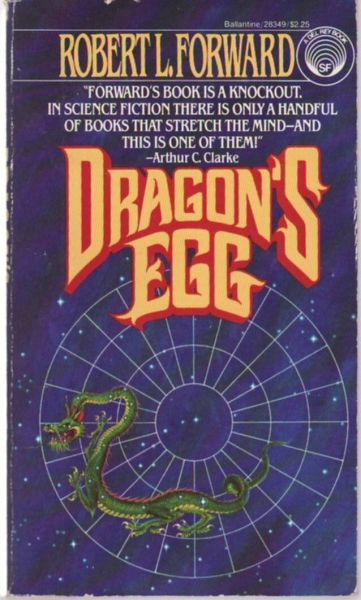Trippin’ on Starlight
Dragon’s Egg (Dragon’s Egg, volume 1)
By Robert L. Forward

9 May, 2021
1980’s Dragon’s Egg is the first novel in Robert L. Forward’s Dragon’s Egg duology.
A supernova transforms a red giant into a neutron star, launching the tiny, dense post-stellar remnant directly at an unsuspecting Solar System. Half a million years later, in April 2020, Jacqueline Carnot, faced with peculiar data from a deep-space Soviet-ESA space probe, realizes that the Solar System is about to have a close encounter with an object that (if it stuck the Earth) would leave very little trace that there was ever an Earth.
If.
However, space is very big, and what counts as a direct hit on a cosmic scale is still a vast distance on a human scale. The neutron star, dubbed Dragon’s Egg, is over 2000 astronomical units away and will approach no closer than 250 astronomical units. The effect on the Earth will be negligible.
The close passage of the neutron star is an unparalleled opportunity to study an uncommon object. Alas, Jacqueline lives in an era in which space exploration has been to a great extent backburnered. Only the unlikely and timely development of paradigm-altering technologies could change this. Jacqueline and people like her will have to settle for studying Dragon’s Egg remotely.
The unlikely and timely development of paradigm-altering technologies — reliable, cheap fusion — is not quite timely enough for Jacqueline to visit her neutron star in person. It is, however, timely enough that her son, Pierre Carnot Niven, along with a crew of fellow scientists, can. By 2050, a crewed spacecraft reaches Dragon’s Egg. Which, as they soon discover, has native life, despite the very alien conditions on the neutron star’s surface.
The Cheela are about the size of a grain of rice, intelligent, and live approximately a million times faster than humans. In 2032, a Cheela discovers tool use. By 2050, many, many generations later, the Cheela develop the rudiments of agriculture and notice new stars in their sky. Over the course of 22 May 2050 to 21 June 2050, Cheela cultures evolve dramatically. Those mysterious stars, which the reader knows to be human spacecraft, feature prominently in the Cheela collective consciousness.
Contact is inevitable, but what meaningful conversation can there be between humans and beings who live but fifteen minutes before dying of old age?
~oOo~
This may be the first SF novel to focus so intently on beings native to a neutron star but it is only the second novel I read that featured them. Poul Anderson’s The Avatar features a passing encounter with an inhabited neutron star.

While parallel invention of ideas is well known in science fiction, in this case I suspect a causal link. The Avatar namechecks Forward in its acknowledgements. Perhaps Forward suggested the idea to Anderson and then decided to write a novel himself.
Forward had help shaping Dragon’s Egg; he gave particular credit to Lester del Rey:
My special thanks to Lester del Rey, who took what was practically a pedantic scientific paper and helped me to turn it into something interesting to read […]
SF readers terrified they may be faced with nuanced characters or lush prose need not fear! Forward’s characters are for the most part paper thin (literally, in the case of the Cheela, who live under almost thirty billion gravities) and the prose is, uh, functional. It’s grammatically correct and the spelling is excellent. Book of the New Sun it ain’t. However, it was never intended to be.
Dragon’s Egg is a hard SF novel, which is to say the point is show off Forward’s shiny idea. Plot and characters exist solely for this purpose. Therefore, the relevant aspects of the humans are those that incline them to notice and study the Cheela; anything more is unexpected luxury, like a gas gauge in a classic VW Beetle. As for the Cheela, Forward fast-forwards through the equivalent of thousands of years of history, from their Stone Age to heights that 21stcentury humans cannot grasp. There is no time to give any Cheela a detailed biography.
Although the Cold War provides a backdrop in the early part of the novel, it’s essentially a non-event. This is because in general Forward rejects conflict as a plot device: people tend towards consensus. This extends to Cheela/Human relations. There’s a lot to fear from aliens who advance from Stone Age to super-science over the course of a summer vacation. There are quite a few SF stories that focus on fears of being outcompeted by Others. Not this novel, however. That’s just not the story Forward wanted to tell.
I don’t think anyone would call this a great novel. Forward’s literary ambitions were perhaps more influenced by his personal connections to a number of influential SF editors and authors than by his skill as a writer. The core idea is nifty. If that is the sort of thing you are looking for, well, here it is.
Dragon’s Egg is available here (Amazon US), here (Amazon Canada), here (Amazon UK), here (Barnes & Noble), here (Book Depository), and here (Chapters-Indigo).
